Astute followers of my Twitter feed (both of you) will know that I recently endured a longish bus ride with the National Express, who are the inter-city bus company over here and who hold the honour of having some the the most uncomfortable seats I've encountered in a long while. They seem specifically designed to create shooting pains in my butt and legs, which is a charming accompaniment to a five and a half hour ride. (Yes I could have taken the train, but at £85 return instead of £45 for the bus, I cheaped out in deference to my continuing state of unempolyedness.) The ride in question was due to a four day jaunt to Devon to visit some distant family and see a few of the sights on offer in the wild west and, National Express aside, I had a lovely time jollying about with my cousin Anne. (And I use the term "cousin" loosely, since I can't be bothed to figure out how many times removed we are because the common ancestry stretches to great and great-great grandparents.) Anne happily ferried me around the arrestingly narrow Devon roads for three days, keeping me amused, fed and distracted.
We visited an old Norman Motte and Bailey Castle in the rain in Totnes:
And spent a day on a short walk along the Devon Coast, including rambling to an excellent pub dating back to 1300, where I had my picture taken with the TARDIS.
But on the third day we braved the trip across the Tamar into the wilds of Cornwall to visit a National Trust property called Lanhydrock House ("Lan-HIGH-drock"). Lanhydrock was a really excellent find, especially for a fan of "Downton Abbey". Though "Downton" isn't actually filmed at Lanhydrock, the history of the house and its inhabitants mirrors the show with eerie accuracy, and the house itself is filled with Downton-era artifacts and stories, making it a great treat for a fan of the show. (What? You're NOT watching Downton Abbey? You're breaking my heart! Go find the first episode and watch it right now. Go ahead. I'll wait.)
I may (or may not) blog about all my holiday activities in more detail at some later point, because for now we're diving back into that recurring blog feature Grub! with a two-for-one offering of Cornish delights, both prepared in the well-appointed restaurants and cafés of Lanhydrock House.
For those not familiar with English geography, Cornwall is the penninsular bit that dribbles down the bottom left of the map in the far southwest. It's notable for a few things - the Cornish Independence movement, the lamentably-pretty-much-dead Cornish language, the Isles of Scilly, and, of course, the Cornish Pasty (pronounced, please please pleeeeez, to rhyme with "nasty" and certainly NOT with "hasty").
A pasty is a variety of the common sort of foodstuff occurring worldwide that involves sticking meat and vegetables into a handy doughy covering (think pie, calzone, samosas, perogies, wontons, spring rolls, blah blah blah...). In a Cornish pasty the filling - usually steak, potato and swede (rutabaga) - is uncooked when sealed into the thick round pastry covering, which is then folded over, crimped shut along the side, and baked into a D shape.
The origins of the pasty are not clear, and probably not necessarily Cornish, though certainly that county has taken the pasty to its heart like nowhere else. The pasty is now the national dish of Cornwall and accounts for 6% of region's food economy. The Cornish pasty also has "Protected Geographical Indication" meaning that pasties prepared outside of Cornwall, or whose manufacture deviates from the designated method, cannot legally be called Cornish pasties. (Pity the poor Cornishwoman who crimps his pasties along the top instead of the side. She may have been doing them that way since her mother's mother's mother's mother first baked them, but they are Cornish pasties no more.)
Though it may have had higher class origins, the pasty gained its foothold in Cornwall as a favourite of Cornish tin miners, who adopted it because it made a hearty and tasty all-in-one lunch that could be eaten hot or cold. It's said that the heavy crimped pastry edge allowed the miners to hold the pasty by the end and eat it down to their grubby fingers, discarding the dirty corner left over. (Nevermind that it's far more likely that they would eat right to the end.) In fact, there's even a now-rare two-course variety of pasty made with savoury filling in one end and sweet in the other, which strikes me as truly brilliant. How lovely would it be to munch down a pasty with a bit of pork, sage and apple stuffed into one end, with more apple, cinnamon and sugar in the other? Inspired!
Pasties can still be had in lots of flavours, and are popular throughout the UK, not just in Cornwall. There's a fast food pasty company with little kiosks all over that has flavours like cheese and onion, steak and Stilton, chicken and leek, lamb and mint, and even oddball varieties like duck and hoisin, which I'm guessing was not high up on the list of your average 19th century tin miner. ("Oi, Curnow we'm 'avin' the hoisin duck fer our croust again?")
(Pasty-related aside: I'd be remiss here if I didn't at least mention the great Pasty-gate scandal of 2012, which occurred when Chancellor George Osborne extended the dreaded 20% VAT (Value Added Tax, analogous to Canada's GST - Goods and Services Tax) to "hot takeaway food". Historically, there's been a grey area between food that is prepared and served hot (VAT taxable) and food that is merely incidentally hot, like fresh-baked bread (VAT exempt). As you can imagine, that ambiguity is one that pasty-makers have been on the non-VAT side of for ages. Osborne jigged the regulations to make it mandatory to tax all hot food, resulting in a great hue and cry and much semi-tongue-in-cheek speculation about how cool a pasty would have to be before it would be tax-exempt. Osborne, David Cameron, and, by extension, the whole Conservative Party, were seen as being "out of touch" with the common pasty-eating public, a perception that was reinforced when it was revealed that the pasty shop in Leeds station where Cameron claimed he had "recently" enjoyed a pasty had actually been out of business for years, revealing Cameron's decidedly toff-like non-pasty-eating nature. Osborne backtracked on the pasty tax in May of 2012, just months after vigorously defending it. It's now possible to buy a cooling pasty VAT-free, though ones kept hot for immediate consumption are still taxable.)
I did pay VAT on my pasty - the traditional steak variety - in Cornwall, and I was not disappointed.
Piping hot, slightly peppery, and entirely satisfying, a good old Cornish pasty was just what I needed to warm me through, fill me up and prepare me to explore all fifty rooms at Lanhydrock House. Which is precisely what I did.

And since we're talking about food - here's a pic of the formal dining room at Lanhydrock, laid out as it was for the luncheon served on the occassion of the visit of King George VI and Queen Elizabeth, in 1950. I noted that pasties were NOT on the menu.
Handily, Anne and I finished our explorations of the main house with time to retire to the Servant's Hall, which has been converted into a nice tea room, for another Cornish treat: the cream tea.
I have already blogged about the wonders of cream here in the UK, and the cream tea showcases what is easily the most decadent of the many sorts available - clotted cream. Clotted cream is a particular specialty of Devon and Cornwall, the two southwest counties, and like Cornish pasties, Cornish clotted cream has protected designation of origin. Clotted cream is traditionally prepared by gently warming whole unhomogenised milk in which the cream has been allowed to rise to the top. The clots of high fat yumminess that form on the top are then skimmed off and become clotted cream. It is decadent beyond belief and should be consumed sparingly but with immense pleasure.
A cream tea has four basic ingredients. First, a proper cup (or preferably pot) of tea. Second, a freshly baked scone (or two) (Do I need to tell you want a scone is? Bah... I can't be bothered. Go look it up yourself if you haven't had the pleasure.) Finally a cream tea needs the toppings for the scones - jam and clotted cream. I realise that the uninitiated might expect you were meant to put the cream in your tea, but that would be very very WRONG. First, because you would never have cream in tea to begin with (milk only, of course) and second because if you tried to put clotted cream in tea it would be a bit like dropping a lump of butter in your cup. At a minimum of 55% and an average of 65% fat, clotted cream is far too thick for that kind of treatment. It is, in fact, thick enough to spoon and spread, which is precisely what it's there for.
There is a slight variation in the cream tea phenomenon as presented in Cornwall as opposed to Devon. In Devon the split scone is first spread with cream, with the jam added on top. In Cornwall, it's jam first, then cream. Being the diligent and thorough blogger I am, and possessing of two perfectly good scones, I made a careful experiment to determine which method is best, while Anne documented every bite.
The results? I think the Cornish method produces superior flavour because you get more cream on the tongue vs. jam. However, the Devon method is easier to spread and would be preferable if you were more about the jam than the cream (but if that were the case then it should really be called a jam tea, which it patently is not). For my money it's the Cornish way, though the differences are subtle at best. Certainly if I were presented with a plate of scones prepared in the Devon fashion I wouldn't turn them down because however it's done, a cream tea is a delight.
And there you have it - two tasty Cornish treats to contemplate while you gnash your teeth enviously at my continuing leisurely lifestyle. No job for me yet, and I confess to getting a bit nervous about things, especially since I was recently denied not only an offer but even an interview for a job I thought I was eminently qualified for. It all leaves me a bit downhearted and puzzled as to what, exactly, this city wants from me. Happily for you this leaves me a lot of time for blogging, so keep watching this space.
We visited an old Norman Motte and Bailey Castle in the rain in Totnes:
Totnes Castle
And spent a day on a short walk along the Devon Coast, including rambling to an excellent pub dating back to 1300, where I had my picture taken with the TARDIS.
The Devon coast on the only dry, sunny day we had.
Anne, on a precipitous decline.
Me and the TARDIS in the pub's back garden. No explanation as to why it was there, but that's kind of how the TARDIS works, isn't it?
Lanhydrock House
I may (or may not) blog about all my holiday activities in more detail at some later point, because for now we're diving back into that recurring blog feature Grub! with a two-for-one offering of Cornish delights, both prepared in the well-appointed restaurants and cafés of Lanhydrock House.
For those not familiar with English geography, Cornwall is the penninsular bit that dribbles down the bottom left of the map in the far southwest. It's notable for a few things - the Cornish Independence movement, the lamentably-pretty-much-dead Cornish language, the Isles of Scilly, and, of course, the Cornish Pasty (pronounced, please please pleeeeez, to rhyme with "nasty" and certainly NOT with "hasty").
A pasty is a variety of the common sort of foodstuff occurring worldwide that involves sticking meat and vegetables into a handy doughy covering (think pie, calzone, samosas, perogies, wontons, spring rolls, blah blah blah...). In a Cornish pasty the filling - usually steak, potato and swede (rutabaga) - is uncooked when sealed into the thick round pastry covering, which is then folded over, crimped shut along the side, and baked into a D shape.
My pasty, exhibiting correct crimping technique and golden brown deliciousness.
The origins of the pasty are not clear, and probably not necessarily Cornish, though certainly that county has taken the pasty to its heart like nowhere else. The pasty is now the national dish of Cornwall and accounts for 6% of region's food economy. The Cornish pasty also has "Protected Geographical Indication" meaning that pasties prepared outside of Cornwall, or whose manufacture deviates from the designated method, cannot legally be called Cornish pasties. (Pity the poor Cornishwoman who crimps his pasties along the top instead of the side. She may have been doing them that way since her mother's mother's mother's mother first baked them, but they are Cornish pasties no more.)
Though it may have had higher class origins, the pasty gained its foothold in Cornwall as a favourite of Cornish tin miners, who adopted it because it made a hearty and tasty all-in-one lunch that could be eaten hot or cold. It's said that the heavy crimped pastry edge allowed the miners to hold the pasty by the end and eat it down to their grubby fingers, discarding the dirty corner left over. (Nevermind that it's far more likely that they would eat right to the end.) In fact, there's even a now-rare two-course variety of pasty made with savoury filling in one end and sweet in the other, which strikes me as truly brilliant. How lovely would it be to munch down a pasty with a bit of pork, sage and apple stuffed into one end, with more apple, cinnamon and sugar in the other? Inspired!
Pasties can still be had in lots of flavours, and are popular throughout the UK, not just in Cornwall. There's a fast food pasty company with little kiosks all over that has flavours like cheese and onion, steak and Stilton, chicken and leek, lamb and mint, and even oddball varieties like duck and hoisin, which I'm guessing was not high up on the list of your average 19th century tin miner. ("Oi, Curnow we'm 'avin' the hoisin duck fer our croust again?")
(Pasty-related aside: I'd be remiss here if I didn't at least mention the great Pasty-gate scandal of 2012, which occurred when Chancellor George Osborne extended the dreaded 20% VAT (Value Added Tax, analogous to Canada's GST - Goods and Services Tax) to "hot takeaway food". Historically, there's been a grey area between food that is prepared and served hot (VAT taxable) and food that is merely incidentally hot, like fresh-baked bread (VAT exempt). As you can imagine, that ambiguity is one that pasty-makers have been on the non-VAT side of for ages. Osborne jigged the regulations to make it mandatory to tax all hot food, resulting in a great hue and cry and much semi-tongue-in-cheek speculation about how cool a pasty would have to be before it would be tax-exempt. Osborne, David Cameron, and, by extension, the whole Conservative Party, were seen as being "out of touch" with the common pasty-eating public, a perception that was reinforced when it was revealed that the pasty shop in Leeds station where Cameron claimed he had "recently" enjoyed a pasty had actually been out of business for years, revealing Cameron's decidedly toff-like non-pasty-eating nature. Osborne backtracked on the pasty tax in May of 2012, just months after vigorously defending it. It's now possible to buy a cooling pasty VAT-free, though ones kept hot for immediate consumption are still taxable.)
I did pay VAT on my pasty - the traditional steak variety - in Cornwall, and I was not disappointed.
Me eating my pasty

And since we're talking about food - here's a pic of the formal dining room at Lanhydrock, laid out as it was for the luncheon served on the occassion of the visit of King George VI and Queen Elizabeth, in 1950. I noted that pasties were NOT on the menu.
I have already blogged about the wonders of cream here in the UK, and the cream tea showcases what is easily the most decadent of the many sorts available - clotted cream. Clotted cream is a particular specialty of Devon and Cornwall, the two southwest counties, and like Cornish pasties, Cornish clotted cream has protected designation of origin. Clotted cream is traditionally prepared by gently warming whole unhomogenised milk in which the cream has been allowed to rise to the top. The clots of high fat yumminess that form on the top are then skimmed off and become clotted cream. It is decadent beyond belief and should be consumed sparingly but with immense pleasure.
A cream tea has four basic ingredients. First, a proper cup (or preferably pot) of tea. Second, a freshly baked scone (or two) (Do I need to tell you want a scone is? Bah... I can't be bothered. Go look it up yourself if you haven't had the pleasure.) Finally a cream tea needs the toppings for the scones - jam and clotted cream. I realise that the uninitiated might expect you were meant to put the cream in your tea, but that would be very very WRONG. First, because you would never have cream in tea to begin with (milk only, of course) and second because if you tried to put clotted cream in tea it would be a bit like dropping a lump of butter in your cup. At a minimum of 55% and an average of 65% fat, clotted cream is far too thick for that kind of treatment. It is, in fact, thick enough to spoon and spread, which is precisely what it's there for.
My cream tea. That bit that looks like a scoop of pale yellow vanilla ice cream?
That's the clotted cream.
Me in careful contemplation of the Devon variety.
Note the Cornish style awaiting judgement on the left.
Note the Cornish style awaiting judgement on the left.
And there you have it - two tasty Cornish treats to contemplate while you gnash your teeth enviously at my continuing leisurely lifestyle. No job for me yet, and I confess to getting a bit nervous about things, especially since I was recently denied not only an offer but even an interview for a job I thought I was eminently qualified for. It all leaves me a bit downhearted and puzzled as to what, exactly, this city wants from me. Happily for you this leaves me a lot of time for blogging, so keep watching this space.
A moody view of the Cornish countryside, to match my moody... errr... mood.



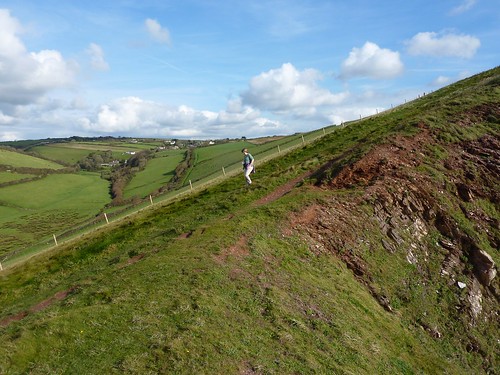


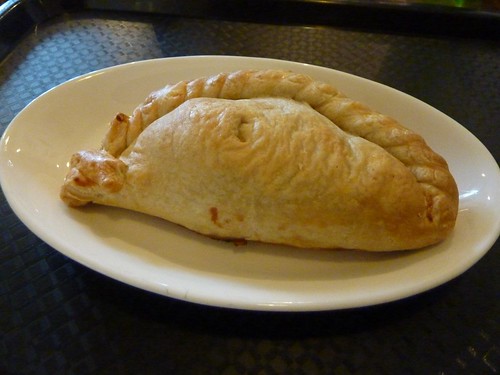

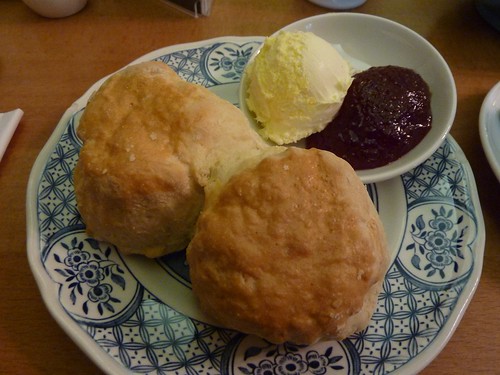
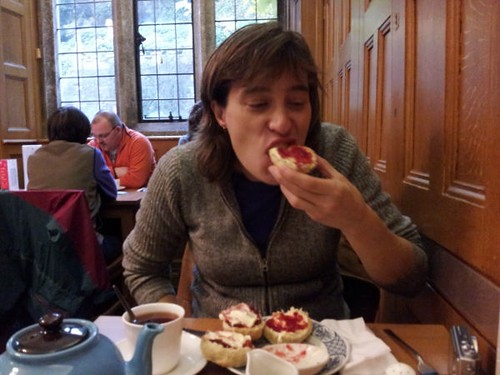
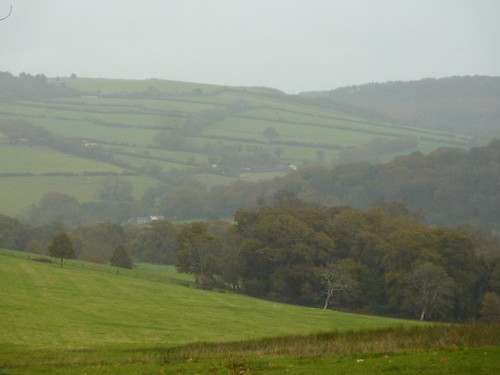


0 Comments:
Post a Comment